 |
| Sienna Miller and Toby Jones in HBO’s The Girl |
The radical notion that women like good movies
 |
| Sienna Miller and Toby Jones in HBO’s The Girl |
 |
| Elizabeth Banks and Brooklyn Decker in What to Expect When You’re Expecting |
 |
| “Dudes Group” of fathers in What to Expect When You’re Expecting |
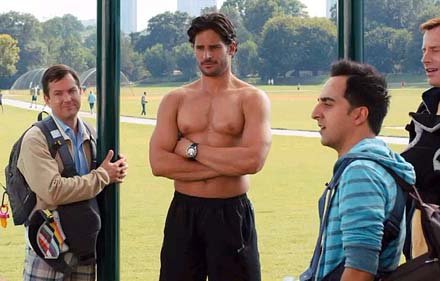 |
| Shirtless Joe Maganiello is one of the best things about living in 2012. |
 |
| Seth MacFarlane, unpleasant person and recently-announced host of the 85th Annual Academy Awards |
2. Billy Ray Cyrus
3. James Franco in a wig made from Anne Hathaway’s Les Mis chop
4. Tom Brokaw after half an Ambien
5. A brigade of mimes from Cirque du Soleil
6. Ben Affleck and Matt Damon [The 90s are BACK, people!]
7. On that note, how about reuniting the dynamic duo of the 1994 Oscars:
 |
| Sam Jackson can play the popcorn. |
 |
| That blue bodybuilder dude from Prometheus |
 |
| Steve Carell and Keira Knightley in Seeking a Friend for the End of the World |
| Keira Knightley as Penny |
 |
| Resident Evil DVD Cover |
 |
| Zombies: something to talk about |
 |
| Michelle Rodriguez as Rain in Resident Evil |
 |
| Spencer Locke as K-Mart and Ali Larter as Claire in Extinction |
 |
| Alice wakes up in an Umbrella Corporation lab. Get used to it, Alice. |
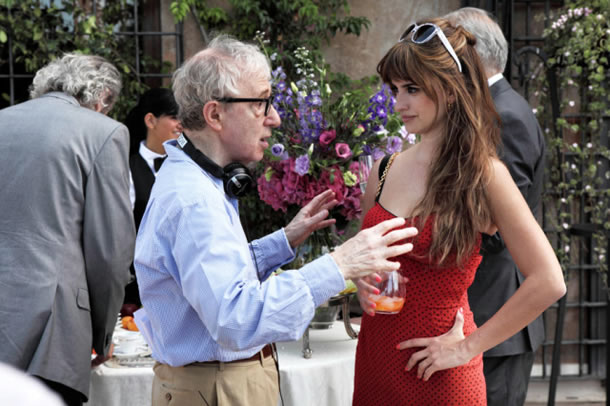 |
| Woody Allen and Penelope Cruz on set of To Rome With Love |
 |
| Michelle Trachtenberg as Dawn Summers |
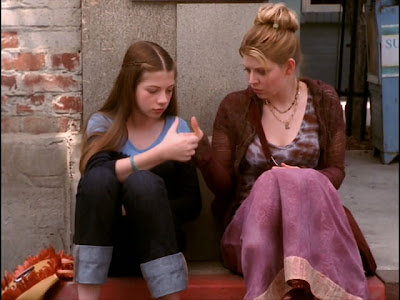 |
| Dawn and Tara, fellow outsiders from the Scooby gang, pass time with a thumb war. |
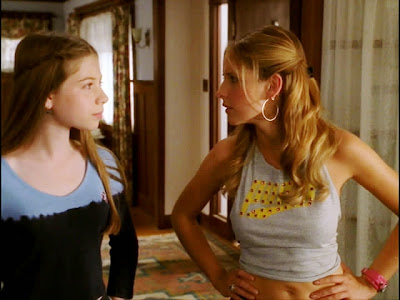 |
| Dawn as annoying little sister. |
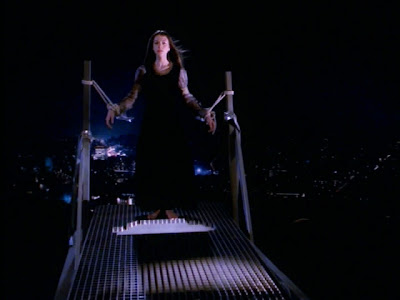 |
| Dawn in damsel-in-distress mode. |
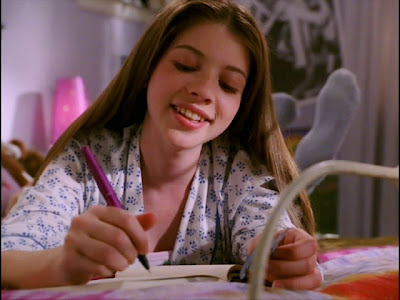 |
| Dawn writes in her diary. |
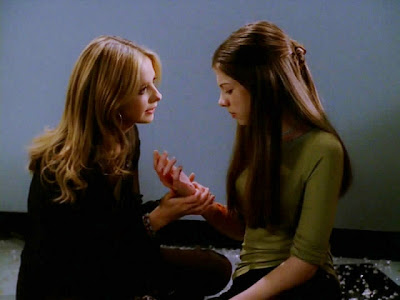 |
| “It doesn’t matter where you came from, or how you got here, you are my sister.” |
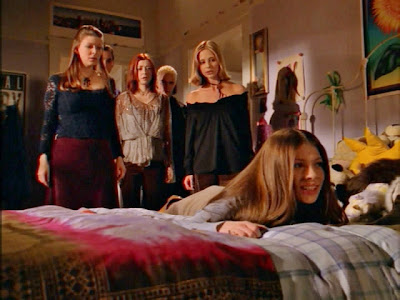 |
| Dawn’s tantrum in Season 6’s “Older and Faraway” |
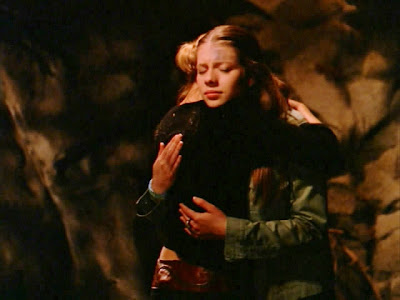 |
| Buffy and Dawn hug in “Grave” |
 |
| Dawn with Buffy during her metaphorical rebirth in “Grave.” |
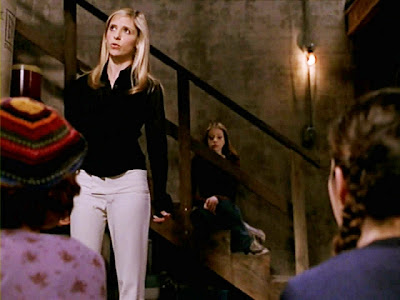 |
| Dawn lurks in the background as Buffy gives a speech to potential slayers. |
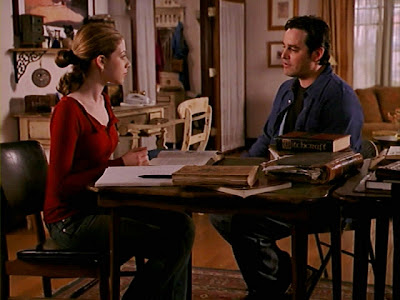 |
| Xander has a heart-to-heart with Dawn |
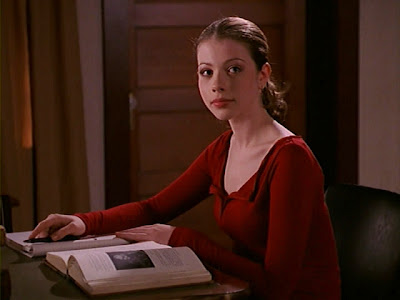 |
| Dawn accepts her humanity and finds her maturity. |
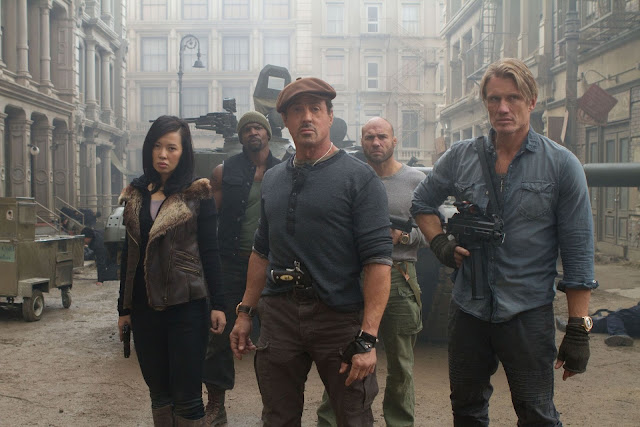 |
| Still from The Expendables 2 [source] |
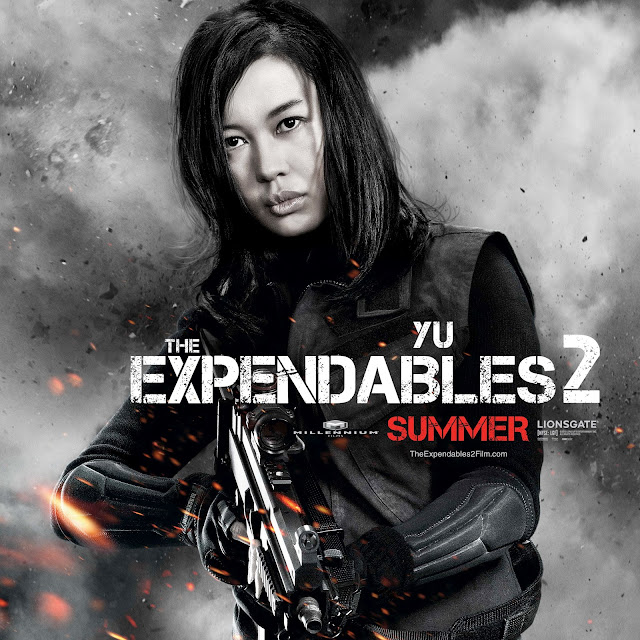 |
| Promotion poster for The Expendables 2 featuring Nan Yu |
 |
| Still from Friends With Kids. [source] |
I’ve been excited to see Friends With Kids since Megan Kearns first wrote about it for Bitch Flicks last March. What a cast! A female writer/director! A romcom with a genuinely new and interesting premise!
I finally got the chance to watch Friends With Kids on a long flight this week, and I tremendously enjoyed watching it, but still found myself wanting more. As Megan expressed in her subsequent review of the film, Friends With Kids falls short of being a “feminist extravaganza” and ultimately isn’t too dissimilar from your standard romantic comedy. I was constantly reminded of When Harry Met Sally… a film that Friends With Kids echoes not only thematically (testing the limits of men and women in platonic relationships) but also structurally (following its characters over the course of several years of their lives) and tonally (witty comedy striped with serious relationship pathos).
Writer/Director/Producer Jennifer Westfeldt also stars as Julie, whose life seems pretty great even though she’s been unlucky in love (one of the most refreshing things about this movie is how it portrays singledom as Not The End Of The World even for a woman who ultimately does want a committed relationship). Her best friend is Jason (Adam Scott, as though that guy needed any more crush points), who favors brief dalliances with large-breasted women to actual relationships. Julie and Jason function as an ersatz couple in their circle of paired-off friends (Maya Rudolph and Chris O’Dowd as the stable and happy partners Leslie and Alex, and Kristen Wiig and Jon Hamm as the more tumultuous pair Missy and Ben). After the rest of the gang starts having children, Jason and Jules surprise everyone by deciding to have a kid together. They both want children and do not want to wait to find “their people” to do so, especially given the negative effects on romantic relationships they’ve seen having children can bring. As best friends, they have a lifelong love and commitment to each other making them suitable co-parents, without having to sacrifice passion or romance to the demands of child rearing.
My disappointment with Friends With Kids is that it doesn’t really explore the promise of that premise. Jules and Jason’s child-rearing arrangement works seemingly effortlessly, and the film fails to really express why. When the movie needs to inject some conflict, Friends With Kids retreats to the well-worn issue of whether a woman and a man can enjoy a truly platonic relationship. Only when romantic drama is thrown into the mix does the pair struggle to divide their time with and responsibilities to their son, which seems to support the wisdom of Jason and Jules’ original arrangement, but in reality nullifies their alternative parenting scheme by suggesting that close male/female friendships are always a pretense ultimately giving way to romance.
Which means that in the end, Friends With Kids doesn’t have that much to say about alternative family structures, which is terribly disappointing. Lip service is paid to gay couples raising children, and a few divorced straight couples with kids appear on the sidelines, but their struggles aren’t really explored. So when our heroes end up as yet another “traditional” family by film’s end, it’s quite the let-down to my feminist hopes for the film.
That said, like with When Harry Met Sally…, my id was tickled to see these two characters find love with each other, even though I still long for a movie that explores a male-female friendship that is genuinely platonic. Jason and Jules were so believable as best friends (I particularly got a kick out of their go-to conversation starter: making the other person choose between two hypothetical causes of death) and initially so believable as people not attracted to each other (their baby-making sex scene was so hilariously awkward I couldn’t help but laugh out loud even though I was watching it on a personal headset with earphones on a crowded airplane) that I was quite surprised when Friends With Kids took the old-fashioned turns it did.
Friends With Kids is still eminently watchable: smart, funny, and really phenomenally cast and acted (this is a movie where even Megan Fox is well-cast!). Given that I like watching even bad romantic comedies, it feels unfair and greedy to emphasize my disappointment with what is a really, really good one, just for not being exactly the kind of movie I wanted it to be.
—
Robin Hitchcock is an American writer currently living in Cape Town, South Africa. She would choose death by shark over death by alligator.
 |
| Still from Friends With Kids. [source] |
I’ve been excited to see Friends With Kids since Megan Kearns first wrote about it for Bitch Flicks last March. What a cast! A female writer/director! A romcom with a genuinely new and interesting premise!
I finally got the chance to watch Friends With Kids on a long flight this week, and I tremendously enjoyed watching it, but still found myself wanting more. As Megan expressed in her subsequent review of the film, Friends With Kids falls short of being a “feminist extravaganza” and ultimately isn’t too dissimilar from your standard romantic comedy. I was constantly reminded of When Harry Met Sally… a film that Friends With Kids echoes not only thematically (testing the limits of men and women in platonic relationships) but also structurally (following its characters over the course of several years of their lives) and tonally (witty comedy striped with serious relationship pathos).
Writer/Director/Producer Jennifer Westfeldt also stars as Julie, whose life seems pretty great even though she’s been unlucky in love (one of the most refreshing things about this movie is how it portrays singledom as Not The End Of The World even for a woman who ultimately does want a committed relationship). Her best friend is Jason (Adam Scott, as though that guy needed any more crush points), who favors brief dalliances with large-breasted women to actual relationships. Julie and Jason function as an ersatz couple in their circle of paired-off friends (Maya Rudolph and Chris O’Dowd as the stable and happy partners Leslie and Alex, and Kristen Wiig and Jon Hamm as the more tumultuous pair Missy and Ben). After the rest of the gang starts having children, Jason and Jules surprise everyone by deciding to have a kid together. They both want children and do not want to wait to find “their people” to do so, especially given the negative effects on romantic relationships they’ve seen having children can bring. As best friends, they have a lifelong love and commitment to each other making them suitable co-parents, without having to sacrifice passion or romance to the demands of child rearing.
My disappointment with Friends With Kids is that it doesn’t really explore the promise of that premise. Jules and Jason’s child-rearing arrangement works seemingly effortlessly, and the film fails to really express why. When the movie needs to inject some conflict, Friends With Kids retreats to the well-worn issue of whether a woman and a man can enjoy a truly platonic relationship. Only when romantic drama is thrown into the mix does the pair struggle to divide their time with and responsibilities to their son, which seems to support the wisdom of Jason and Jules’ original arrangement, but in reality nullifies their alternative parenting scheme by suggesting that close male/female friendships are always a pretense ultimately giving way to romance.
Which means that in the end, Friends With Kids doesn’t have that much to say about alternative family structures, which is terribly disappointing. Lip service is paid to gay couples raising children, and a few divorced straight couples with kids appear on the sidelines, but their struggles aren’t really explored. So when our heroes end up as yet another “traditional” family by film’s end, it’s quite the let-down to my feminist hopes for the film.
That said, like with When Harry Met Sally…, my id was tickled to see these two characters find love with each other, even though I still long for a movie that explores a male-female friendship that is genuinely platonic. Jason and Jules were so believable as best friends (I particularly got a kick out of their go-to conversation starter: making the other person choose between two hypothetical causes of death) and initially so believable as people not attracted to each other (their baby-making sex scene was so hilariously awkward I couldn’t help but laugh out loud even though I was watching it on a personal headset with earphones on a crowded airplane) that I was quite surprised when Friends With Kids took the old-fashioned turns it did.
Friends With Kids is still eminently watchable: smart, funny, and really phenomenally cast and acted (this is a movie where even Megan Fox is well-cast!). Given that I like watching even bad romantic comedies, it feels unfair and greedy to emphasize my disappointment with what is a really, really good one, just for not being exactly the kind of movie I wanted it to be.
—
Robin Hitchcock is an American writer currently living in Cape Town, South Africa. She would choose death by shark over death by alligator.
 |
| Still from Friends With Kids. [source] |
I’ve been excited to see Friends With Kids since Megan Kearns first wrote about it for Bitch Flicks last March. What a cast! A female writer/director! A romcom with a genuinely new and interesting premise!
I finally got the chance to watch Friends With Kids on a long flight this week, and I tremendously enjoyed watching it, but still found myself wanting more. As Megan expressed in her subsequent review of the film, Friends With Kids falls short of being a “feminist extravaganza” and ultimately isn’t too dissimilar from your standard romantic comedy. I was constantly reminded of When Harry Met Sally… a film that Friends With Kids echoes not only thematically (testing the limits of men and women in platonic relationships) but also structurally (following its characters over the course of several years of their lives) and tonally (witty comedy striped with serious relationship pathos).
Writer/Director/Producer Jennifer Westfeldt also stars as Julie, whose life seems pretty great even though she’s been unlucky in love (one of the most refreshing things about this movie is how it portrays singledom as Not The End Of The World even for a woman who ultimately does want a committed relationship). Her best friend is Jason (Adam Scott, as though that guy needed any more crush points), who favors brief dalliances with large-breasted women to actual relationships. Julie and Jason function as an ersatz couple in their circle of paired-off friends (Maya Rudolph and Chris O’Dowd as the stable and happy partners Leslie and Alex, and Kristen Wiig and Jon Hamm as the more tumultuous pair Missy and Ben). After the rest of the gang starts having children, Jason and Jules surprise everyone by deciding to have a kid together. They both want children and do not want to wait to find “their people” to do so, especially given the negative effects on romantic relationships they’ve seen having children can bring. As best friends, they have a lifelong love and commitment to each other making them suitable co-parents, without having to sacrifice passion or romance to the demands of child rearing.
My disappointment with Friends With Kids is that it doesn’t really explore the promise of that premise. Jules and Jason’s child-rearing arrangement works seemingly effortlessly, and the film fails to really express why. When the movie needs to inject some conflict, Friends With Kids retreats to the well-worn issue of whether a woman and a man can enjoy a truly platonic relationship. Only when romantic drama is thrown into the mix does the pair struggle to divide their time with and responsibilities to their son, which seems to support the wisdom of Jason and Jules’ original arrangement, but in reality nullifies their alternative parenting scheme by suggesting that close male/female friendships are always a pretense ultimately giving way to romance.
Which means that in the end, Friends With Kids doesn’t have that much to say about alternative family structures, which is terribly disappointing. Lip service is paid to gay couples raising children, and a few divorced straight couples with kids appear on the sidelines, but their struggles aren’t really explored. So when our heroes end up as yet another “traditional” family by film’s end, it’s quite the let-down to my feminist hopes for the film.
That said, like with When Harry Met Sally…, my id was tickled to see these two characters find love with each other, even though I still long for a movie that explores a male-female friendship that is genuinely platonic. Jason and Jules were so believable as best friends (I particularly got a kick out of their go-to conversation starter: making the other person choose between two hypothetical causes of death) and initially so believable as people not attracted to each other (their baby-making sex scene was so hilariously awkward I couldn’t help but laugh out loud even though I was watching it on a personal headset with earphones on a crowded airplane) that I was quite surprised when Friends With Kids took the old-fashioned turns it did.
Friends With Kids is still eminently watchable: smart, funny, and really phenomenally cast and acted (this is a movie where even Megan Fox is well-cast!). Given that I like watching even bad romantic comedies, it feels unfair and greedy to emphasize my disappointment with what is a really, really good one, just for not being exactly the kind of movie I wanted it to be.
—
Robin Hitchcock is an American writer currently living in Cape Town, South Africa. She would choose death by shark over death by alligator.
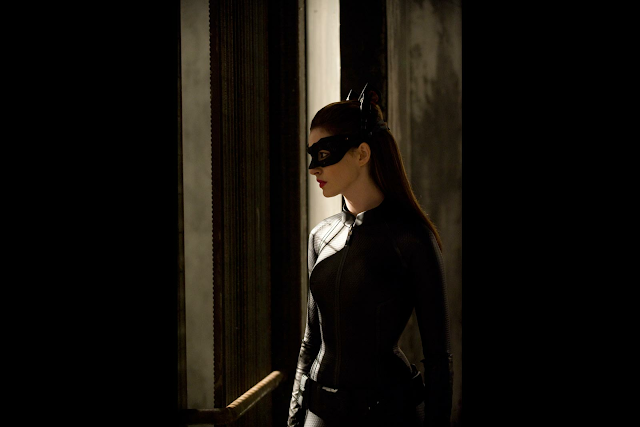 |
| Anne Hathaway as Catwoman in The Dark Knight Rises [source] |
While The Dark Knight Rises has had a more mixed reception than Christopher Nolan’s previous two entries in his Batman trilogy, everyone, even President Obama, can agree that Anne Hathaway’s Catwoman was the best thing about the movie. Slate’s Alyssa Rosenberg calls her, “the best Catwoman ever to grace the big screen.”
And I loved her too. The Dark Knight Rises‘s Selina Kyle is smart, sexy, and complex in her morality: the trinity of characteristics that unites all incarnations of Catwoman. The other details of Selina and her alter-ego Catwoman shift constantly (a fate common to comic book characters). She’s been an amnesiac flight attendant abuse victim (in the Gold and Silver Age comics in which she first appeared), a wealthy socialite who burgles for the thrill of the hunt (how she was portrayed in my introduction to the character, Batman: The Animated Series), a meek secretary transformed into a badass vigilante after her apparent murder by her powerful boss (in Batman Returns), and, well, whatever Halle Berry was reduced to doing with the character (who, just to be clear, was not Selina Kyle, but rather Patience Phillips, and I will waste no more words on a character and film that is best forgotten). As Rosenberg puts it in her Slate piece, “Catwoman has, in the past, been a rich well for explorations of female trauma.”
So it was inevitable that Selina Kyle be portrayed as a sex worker, at least once Frank Miller got his hands on her. Christopher Nolan’s Batman trilogy has always been transparently inspired by Miller’s seminal comics Batman: Year One and The Dark Knight Returns. The former series first introduced Selina Kyle as prostitute:
| Sex worker Selina Kyle in panels from Frank Miller’s Batman: Year One [source] |
And over the next twenty years or so of DC comics, the prostitute origin story would be hinted at, overtly dropped, slyly repackaged, forgotten, and popped back in at the whims of various comic book writers. Brian Cronin provides a thorough overview of the waxing and waning of this storyline in his Abandoned An’ Forsaked column. When it was announced that Hathaway had been cast as Selina Kyle in The Dark Knight Rises, speculation went wild regarding which Catwoman we’d get.
As it should be, The Dark Knight Rises offers a unique take on the character. And it stays cagey about her life’s details and origin story. But watching the film, I inferred that they were incorporating the sex worker background for the character. On the ride home from the theater I mentioned it to my husband, who is not a comic book reader, and he was bewildered how I had gotten that impression.
[SPOILERS for The Dark Knight Rises FORTHWITH]
As a comic book fan, I came in with the expectation that this movie’s version of Selina Kyle might be a sex worker. Because I knew Selina Kyle had been portrayed as one, most notably by Frank Miller, whose work has been so influential on the trilogy. So when Anne Hathaway’s Kyle seduces and absconds with a Congressperson (to provide herself with cover when she makes an illicit exchange, we discover) I figured she was doing this in the course of her business.
As that deal goes down, another character is introduced: Selina’s friend, played by Juno Temple, and according to IMDb named “Jen.” I don’t recall her being addressed by name in the film, but as soon as I saw her I thought to myself, “Oh, hey, it’s Holly Robinson!”
| Holly Robinson as drawn by Cameron Stewart in Catwoman Secret Files [source] |
Holly Robinson was created by Frank Miller in Batman: Year One, a fellow sex worker living with Selina Kyle. The appearance of that character, even though they’ve given her another name, signaled to me this character was meant to be in line with Miller’s Selina Kyle, a sex worker.
There’s also an offhand reference to Kyle living in “Old Town,” which I’ve never encountered in Batman comics (although there are many thousands I’ve never read, so maybe I am missing something) but which instantly called to mind the prostitute-run red light district of another Frank Miller comic, Sin City.
Selina Kyle’s primary motivation throughout The Dark Knight Rises is acquisition of the “Clean Slate,” a bit of technology that will erase her record, even her very existence, from the world’s databases, allowing her to escape an unspecified past where “she did what she had to do to survive.” Her past could be anything. It could merely be the thieving she’s clearly so adept at. But Kyle very pointedly shows no shame about her burgling, wearing Martha Wayne’s stolen string of pearls while dancing with Bruce at a gala, for example. It stands to reason there is something else she is running away from.
If you accept that The Dark Knight Rises‘s Kyle has a past or present as a sex worker, unfortunately the dynamic character seems much less innovative and much more like yet another iteration of the trope of the Hooker with the Heart of Gold.
The stock character of the Hooker with a Heart of Gold is problematic, even from a sex-work-positive feminist perspective, because the trope itself is not sex work positive. These characters are meant to be interesting because they are good “inside” even though they do “bad” things. The viewer is allowed to be titillated by the character’s occupation without needing to feel as though they condone it. And because hookers with hearts of gold are so often “saved” by men, it plays to a variety of male fantasies beyond women as commodities: that women need them; that women are “correctable.” The trope also reinforces traditional gender roles by masculinizing work for pay, often giving the hookers with hearts of gold tough, emotionally cool exteriors on the job (like men!) that when cracked (by a man!) show their soft, compassionate, womanly true self.
As we have with Selina Kyle in The Dark Knight Rises, who steals and betrays and displays a general disdain for everyone she speaks with in the first half of the movie (other than Holly Robinson’s stand-in). But somehow Batman cracks that ice, first getting Selina Kyle to display emotional vulnerability, and finally inspiring Catwoman to heroically help save the same Gotham she’d been keen to abandon after helping it fall to anarchy. When we spot her casually dining with Bruce Wayne in Florence at film’s end, it’s easy to imagine she’s given up her criminal ways: another soiled dove lifted to grace by a good man.
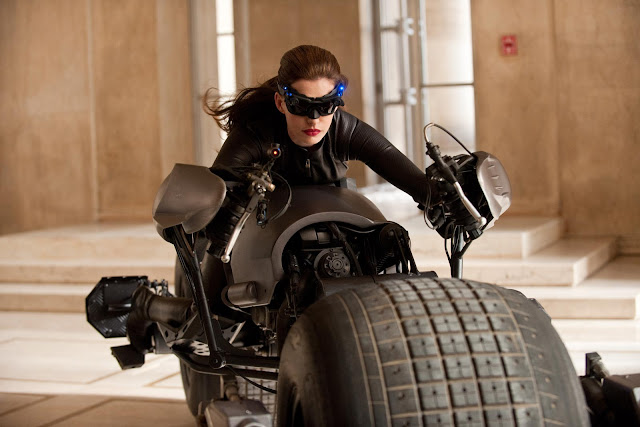 |
| Anne Hathaway as Catwoman, in hero-mode on the Bat Pod. [source] |
Even though I just wrote it, I find this summary of The Dark Knight Rises‘s arc for Selina Kyle overly reductive, and Anne Hathaway’s phenomenal performance in the role nuanced and charismatic enough that it elevates the material. Which is why I don’t so much object that The Dark Knight Rises invokes the trope of the Hooker with a Heart of Gold, I just mind that it does so covertly. It weakens the film’s ability to twist the trope and present a feminist take on it, and wastes an opportunity to give the world an iconic, heroic, feminist character who does or did sex work.
So it doesn’t bother me that The Dark Knight Rises possibly included sex work in the character background of its Catwoman, but it bothers me that they didn’t commit to it. The film signals dog whistles to comic book fans and enable the character and movie to enjoy all the male-id-pleasing benefits of the Hooker With a Heart of Gold trope, without actually having to go to all the trouble of crafting a modern and respectable portrayal of the sex industry in a major summer blockbuster. It’s lazy, even cowardly, and Catwoman, Anne Hathaway, and us movie-watchers all deserved better.
—
Robin Hitchcock is an American writer currently living in Cape Town, South Africa. She had to take the long way home for weeks while The Dark Knight Rises filmed in her neighborhood in Pittsburgh.